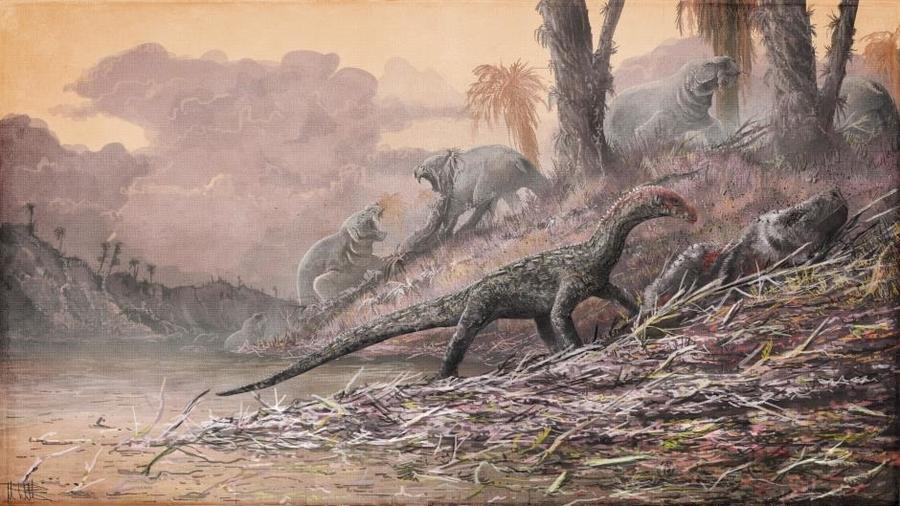The Independent's journalism is supported by our readers. When you purchase through links on our site, we may earn commission.
'Hugely exciting' fossil discovery hailed as missing link in our understanding of dinosaur evolution
'Teleocrater blows holes in many of our classic ideas of dinosaur origins'

Your support helps us to tell the story
From reproductive rights to climate change to Big Tech, The Independent is on the ground when the story is developing. Whether it's investigating the financials of Elon Musk's pro-Trump PAC or producing our latest documentary, 'The A Word', which shines a light on the American women fighting for reproductive rights, we know how important it is to parse out the facts from the messaging.
At such a critical moment in US history, we need reporters on the ground. Your donation allows us to keep sending journalists to speak to both sides of the story.
The Independent is trusted by Americans across the entire political spectrum. And unlike many other quality news outlets, we choose not to lock Americans out of our reporting and analysis with paywalls. We believe quality journalism should be available to everyone, paid for by those who can afford it.
Your support makes all the difference.Fossilised remains of giant reptile which walked the Earth some 245 million years ago have been hailed as a missing link in scientists’ understanding of the origin of the dinosaurs.
Researchers said the crocodile-like creature, called Teleocrater rhadinus, “blows holes in many of our classic ideas of dinosaur origins”.
An early dinosaur relative but not an actual ancestor, the reptile was carnivorous, up to 10ft in length with a long neck and tail, and walked on four legs similar to those seen on crocodiles today.
Previously palaeontologists had thought such animals would have looked like more like two-legged dinosaurs – but reduced to about the size of a chicken.
One of the researchers, Dr Richard Butler, of Birmingham University, said: “Teleocrater fundamentally challenges our models of what the close relatives of dinosaurs would have looked like.
“'Dinosaurs were amazingly successful animals. It's natural to want to know where they came from, and how they became so dominant.
“Teleocrater is hugely exciting because it blows holes in many of our classic ideas of dinosaur origins.”
A statement issued by Birmingham University about the study said it filled a “critical gap in the fossil record of dinosaur cousins”.
The Teleocrater lived just after a group of reptiles called the archosaurs split into two branches. One became dinosaurs and, ultimately, birds, while the other evolved today’s crocodiles and alligators.
The fossils were first discovered in the Ruhuhu Basin in southern Tanzania in 1933 by palaeontologist Rex Parrington.
However its place in the evolutionary tree was unclear due to a lack of key bones, such as the ankles.
Dr Butler and colleagues in the US, Argentina, South Africa, Russia and Sweden re-examined the specimens and others found by a team from Virginia Tech in Tanzania in 2015.
This enabled the researchers to work out that Teleocraters and their kin were the earliest known members of the dinosaur-bird branch of the archosaurs.
“It’s astonishing to think that it’s taken more than 80 years for the true scientific importance of these fossils to be understood and published,” Dr Butler said.
Commenting on the research, Judy Skog, programme director at the US National Science Foundation’s Division of Earth Sciences, said: “This research sheds light on the distribution and diversity of the ancestors of crocodiles, birds, and dinosaurs and indicates that dinosaur origins should be re-examined now that we know more about the complex history and traits of these early ancestors.”
The National Science Foundation helped fund the research along with the National Geographic Society, Russian Government and others.
One of the researchers Professor Paul Barrett, of the Natural History Museum, worked with the late Dr Alan Charig who studied the fossils in the 1950s.
“My colleague Alan Charig would have been thrilled to see one of ‘his’ animals finally being named and occupying such an interesting position in the Tree of Life,” he said.
“Our discovery shows the value of maintaining and re-assessing historical collections: many new discoveries, like this one, can be made by looking through museum collections with fresh eyes.”
A paper about the fossils was published in the journal Nature.
Join our commenting forum
Join thought-provoking conversations, follow other Independent readers and see their replies
0Comments